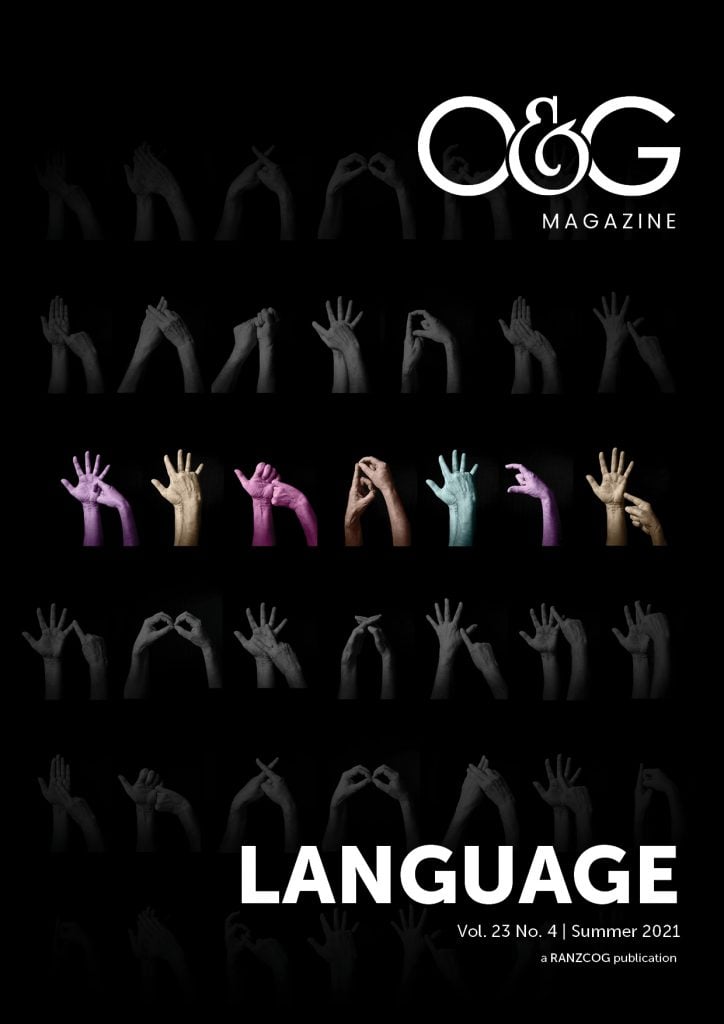Language is a powerful medium, both written words, and probably more importantly in maternity care, our spoken words. The words we choose to use or not use is complex and not always well thought through, especially in stressful situations. As a midwife, I have had my fair share of getting it wrong over many years – and I suspect I still do from time to time. Now, behind a mask, a face shield and sometimes in full personal protection equipment (PPE), it can feel even harder. Receiving feedback from, and through, facial expressions is also more difficult. So, I write this in full acknowledgement of the challenges faced in the sector, especially at the moment, and I suspect minding our language is possibly not high on the list of priorities for many – and understandably so. However, there is no doubt that language matters and probably more so than ever at this time when women’s experience of maternity is so altered in so many ways due to COVID-19 restrictions and challenges.1 Women receiving maternity care, more than ever, need to be informed, empowered, supported and enabled. The words we use can assist women to have a positive experience, but they can also be disempowering and deflating.
When I trained as a midwife, now more than 30 years ago, I confess to not thinking about the words I used or heard others use. I came from a very conventional and hierarchal training as a nurse in a hospital that, looking back, felt more military than healthcare. As a midwifery student, I happily talked about ‘my patients’, the ‘lady (or girl) in room 3’, the ‘primip in bed 2 who has been ARM’ed’, ‘my deliveries’ and what ‘we’ were happy to ‘allow’ women to do. I was desperate to quickly learn and be able to use all the new terminology to fit in. Labelling women with terms like ‘failure to progress’, the ‘incompetent cervix’, the ‘failed homebirth’, the ‘failed VBAC’, being ‘only’ 3cm and enthusiastically documenting all these failings in their medical records, ensured I fitted in and did well as a student. I have no idea what the women thought of this – reflecting or debriefing with women or receiving open feedback was not something that was in the culture of the time. In hindsight, I cringe at the thought of so much patronising, power-laden language and so many alleged failings for women to start motherhood carrying.
Fortunately, in the years that followed graduation, I have become a lot more reflective, and hopefully more thoughtful, about the power of language. My friend and colleague, Prof Nicky Leap, first brought these issues to the attention of midwives with her paper ‘The Power of Words’, published in 1992.2 Nicky argued that the dynamics of using words like ‘allowing’ and ‘managing’, of making sexist innuendos, or jollying women along, belittles and trivialises them and their experiences. She challenged midwives to rethink the words we used – at the simplest level, acknowledging that it was the woman who gave birth, rather than us delivering them and reframing all the failures. In 2012, Nicky re-visited the piece again highlighting the potential impact of the words, especially the way words manifest power in any situation.3 She argues that word choice is a deeply political process that challenges us to consider inequalities, particularly those associated with sexism, racism, class and homophobia.
The words we use reflect the power dynamics and values of our culture and our heritage – personally and professionally. In maternity care, the words we use can also perpetuate hierarchies and contribute to a lack of shared decision making with women. Our love in healthcare of abbreviations and acronyms is one example of further distancing women from shared understandings and ensuring that we, as the provider, remain in charge. When we write and say things like VBAC, ARM, IUGR, VTE, PE and dozens of other examples, we speak in code and this usually means the women we attend are kept in the dark. Terms of endearment are another difficult area that I feel have reduced in usage somewhat but I am sure still exist in some contexts. Well-meaning terms such as ‘dear’ or ‘love’ may make one woman feel cherished and another woman shrink away from us as she grapples with what she sees as inappropriate or patronising familiarity.
More recently, I have also argued that we need to rethink the words that we use in terms of stillbirth, both in practice and in academic writing.4 Women, their partners and families who experience stillbirth are equally impacted by the words we use and, in many instances, these words stay with them forever as there are no new memories of a baby growing up to replace those words. Terms such as fresh stillbirths and macerated stillbirths can feel brutal and dehumanising – especially to a bereaved family. Rethinking how to express stillbirth in a respectful and kind way is needed – perhaps referring to the timing of the death – a stillbirth during pregnancy, or one that occurred in labour is better?
Another topical area is use of the word ‘vulnerable’. In the COVID-19 era, this word is used a lot, especially describing groups who have inequitable access to services, care and vaccination as well as those disproportionally impacted by lockdowns and other restrictions. Colleagues and I have also recently challenged the use of this word in an effort to reframe the focus.5 In this piece, we argue that deficit terms like vulnerable can conceal wider structural causes that lead to health inequities and obscure accountability of those responsible for generating or perseverating these causes and structural power imbalances. Outlining the characteristics and circumstances that may give rise to vulnerability refocuses the issue to a wider system of issues that need to be addressed.
In the last 30 years, one area that maternity care providers have done well is to recognise that the women we attend are not necessarily ‘patients’ or want to be referred to as such. Most maternity care providers, hospitals and health systems are now very thoughtful about referring to women and shifting the power balance from a potentially ‘helpless’ patient to an informed and engaged woman as being central to the care. Woman-centred care is firmly entrenched as a fundamental philosophy and approach in maternity care in policy6 and practice.7 It is therefore disturbing that there is a move to make women invisible with terms such as ‘pregnant and birthing people’. I have previously written about this in Women and Birth, recognising and respecting the increasing rejection of a binary approach to sex and gender and I also know that Trans and gender diverse people face substantial injustices, including violence and discrimination.8 Of course, when caring for individuals it is essential to use the person’s preferred personal pronouns and words that are acceptable to them. However, at a population or collective level, I find it very difficult (actually impossible) to erase the words ‘woman and women’ given the years of struggle to reduce marginalisation, highlight gender inequities and remove invisibility. I will still keep talking about, and writing about, woman and women especially in relation to maternity care.
Deciding which words we will try not to use is not straightforward. It is difficult to stop using words and phrases that are entrenched in everyday maternity practice, in our electronic records and in the terminology that surrounds us in conversation, documentation and signage. Changing long-standing traditions and accepted words and phrases is hard and takes courage. Being the word police is also not fun so we need to find acceptable and sometimes light-hearted ways of influencing change. Helping people identify words that they might choose to change needs to also be done with kindness and generosity of spirit and we cannot, and must not, resort to humiliation, belittling or bullying.
For all of us, no matter our cultural origins or perspectives, words inevitably provoke a myriad of meanings and can cause us to question our own values, belief structures and ways of being.3 Ultimately though, being open to change and being brave enough to reflect with women, their families and with our colleagues can only help our learning about the impact of the words we use and working out how best to move forward in a positive way.
Our feature articles represent the views of our authors and do not necessarily represent the views of the Royal Australian and New Zealand College of Obstetricians and Gynaecologists (RANZCOG), who publish O&G Magazine. While we make every effort to ensure that the information we share is accurate, we welcome any comments, suggestions or correction of errors in our comments section below, or by emailing the editor at [email protected].
References
- Bradfield Z, Wynter K, Hauck Y, et al. Experiences of receiving and providing maternity care during the COVID-19 pandemic in Australia: A five-cohort cross-sectional comparison. PLoS One. 2021;16(3):e0248488. doi: 10.1371/journal.pone.0248488.
- Leap N. The Power of Words. Nursing Times. 1992;88(12):60-61.
- Leap N. The Power of Words Revisited. Essentially MIDIRS 2012;3(1):17-21.
- Ravaldi C, Vannacci A, Homer C. Respectful language in intrapartum and newborn care. Lancet Global Health. 2021;9(1):e17. doi: 10.1016/S2214-109X(20)30462-9.
- Munari S, Wilson A, Blow N, et al. Rethinking the use of ‘vulnerable’. Australian and New Zealand Journal of Public Health. 2021;45(3):197-99. doi: https://doi.org/10.1111/1753-6405.13098.
- Department of Health. Woman-centred care: Strategic directions for Australian maternity services. Cenberra: Commonwealth of Australia, 2019.
- Department of Health. Clinical Practice Guidelines: Pregnancy Care. Canberra: Australian Government Department of Health, 2020. Available from: www.health.gov.au/resources/pregnancy-care-guidelines.
- Homer C, Wilson A, Davis D. Editorial: Words matter; language matters. Women and Birth. 2020;33(2):105-06. doi: 10.1016/j.wombi.2020.02.003.






Leave a Reply